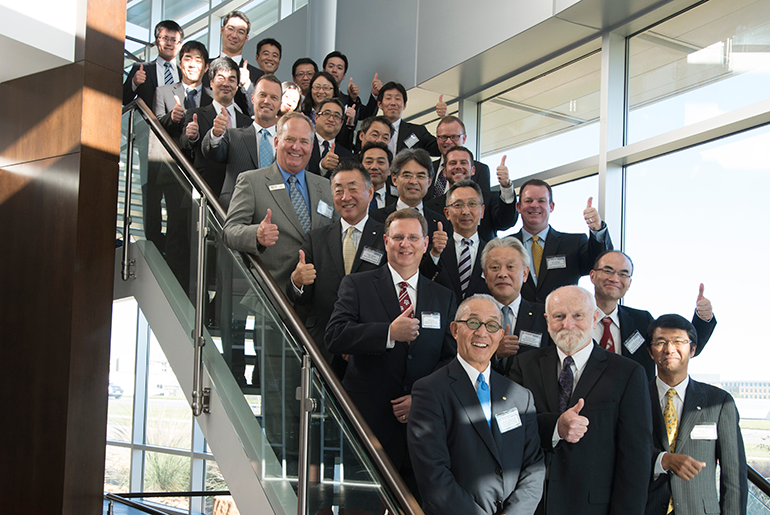
The partnership between Kaneka, a Japanese-based chemical manufacturer, and the Texas A&M Engineering Experiment Station’s (TEES) Polymer Technology Center (PTC) dates back to 1999. Kaneka first approached Dr. Hung-Jue Sue, TEES professor and director of PTC, about his research on improving the toughness of epoxy resin. The collaboration that followed was a success. Kaneka commercialized the product, which led to the partnership the two currently have.
That partnership led to the establishment of the Kaneka U.S. Materials Research Center (KMR) on the Texas A&M campus in College Station in 2013. It was Kaneka’s first corporate research and development center outside of Japan. Current research includes incorporating nanoparticles to improve polymer functionalities, improving nanoparticle dispersion and organization in polymer matrices, and finding new functionalities for polymers.
According to Dr. Masaya Kotaki, general manager of KMR, strengthening the existing relationship between Sue and Kaneka was the primary reason for establishing KMR in College Station. That, combined with PTC’s facilities and capabilities, as well as Texas A&M University’s proximity to Kaneka’s United States headquarters in Pasadena, Texas, made College Station an ideal location for their research and development.
“We have many projects,” Kotaki said. “We need equipment, we need people to train to teach the things that we’re working on, and everything we need is on campus. The people, the information and the equipment are here. This is a perfect place for us. Texas A&M does a very good job of training students and researchers.”
Today, a little more than two years in, the two sides agree that their partnership has been a tremendous success. Kotaki said KMR started with just two researchers in College Station, and are now up to 10. He added that this is just the beginning.
“We definitely want to maintain and improve our relationship with the Polymer Technology Center,” he said. “At this moment, we have a few researchers, and we would like to increase the number in that agreement. We want to work on many different topics with different professors. That’s the future plan we have.”
For Kaneka, the advantage of working with TEES and Texas A&M is the ability to utilize the university’s personnel and facilities.
For PTC, one benefit of collaborating with a company such as Kaneka is the ability to commercialize research. Sue said the partnership has worked better than he possibly could have hoped for.
“It is as good as you can dream of as a professor,” he said. “You have your research being appreciated by a company, and it’s being turned into products and sold globally, and you’re a member of that contribution team. That really allows us to go beyond what we could have done by doing it ourselves.
“When you begin to team up with people in the business world, you realize that research is only one factor of success. Without this experience, I wouldn’t appreciate how important it is to market and sell, and what kind of information you need to provide in order to succeed.”
The collaboration between Kaneka and PTC has resulted in several patents, and Sue also uses the partnership as an example to students about how research can be used to contribute to a company, and how those contributions can make their way into the real world.
Kaneka has provided $20,000 in scholarships to Texas A&M students annually through PTC in the last three years, and has hired several Texas A&M graduates.
Sue emphasizes that the partnership goes beyond the financials and serves as an example of how to conduct research and business.
“Early on in our partnership, I was very clear about our research, including the pros and cons, and advantages and disadvantages of what we do,” Sue said. "Once you make it clear to your sponsors, and you get that trust, then everything that follows becomes easy. I think that’s one reason that we’ve been able to work with Kaneka so well, and something we can all learn from.”
Sue said another benefit of this type of partnership is that it allows for fundamental research.
“This kind of funding allows us to do long-term, critical research,” he said. “We don’t have to look at everything short term as an immediate product or immediate result. That kind of relationship allows us to do the best quality research we can.”
Kotaki also believes that one of the biggest advantages of the partnership is simply the environment. Working in a collegiate setting allows for what could be described as competitive collaboration.
“I like the environment of a university; it’s very different,” he said. “I think this environment is good for us. We can be very competitive. Professors at universities work hard on fundamental research. They collaborate, but they also compete, so this kind of environment is very important for us.”
